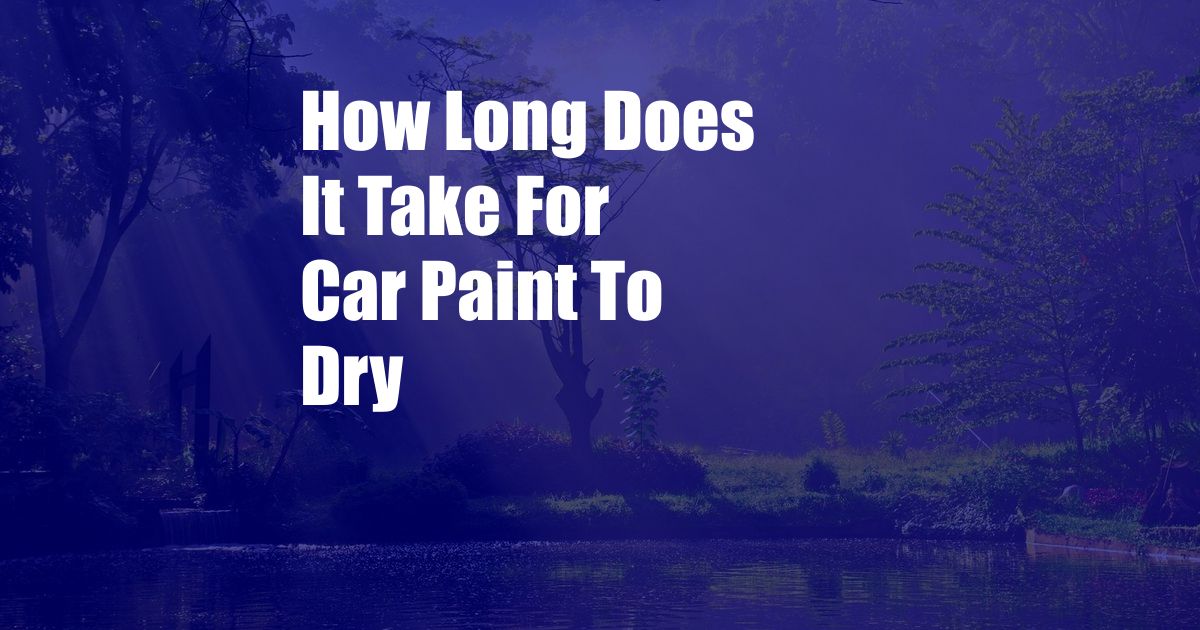
How Long Does It Take for Car Paint to Dry?
I’ve always been fascinated by the process of painting cars. There’s something about the transformation from a dull, lifeless piece of metal into a vibrant, eye-catching work of art that’s simply captivating. One aspect of car painting that I’ve always been curious about is the drying time. After all, who wants to wait around for hours on end for their new paint job to dry? In this article, we’ll take a deep dive into the world of car paint drying times, exploring the factors that affect it and providing tips to speed up the process.
Before we delve into the specifics, let’s first understand the basics of car paint drying. When you apply a coat of paint to your car, it undergoes a process called “curing.” During this process, the paint’s solvents evaporate, allowing the paint to harden and form a durable finish. The curing time can vary depending on a number of factors, including the type of paint, the temperature, and the humidity.
Factors Affecting Car Paint Drying Time
Let’s now take a closer look at the factors that can affect the drying time of car paint:
- Type of Paint: Different types of paint have different drying times. For example, water-based paints typically dry faster than oil-based paints.
- Temperature: The temperature plays a crucial role in the drying process. Warmer temperatures accelerate the evaporation of solvents, leading to faster drying times. However, if the temperature is too high, the paint may dry too quickly and result in cracking or peeling.
- Humidity: Humidity can also affect the drying time. Higher humidity levels slow down the evaporation process, resulting in longer drying times.
- Ventilation: Good ventilation helps to circulate air and remove solvents from the paint. This can significantly speed up the drying process.
- Coating Thickness: The thickness of the paint coating also affects the drying time. Thicker coatings take longer to dry than thinner ones.
Tips to Speed Up Car Paint Drying Time
If you’re impatient and want to speed up the drying process of your car paint, here are a few tips:
- Choose Quick-Drying Paint: Opt for water-based paints or paints specifically designed for quick drying.
- Work in a Warm and Dry Environment: Set up your painting area in a warm and dry location. Consider using a heater or fan to raise the temperature and reduce humidity.
- Ensure Proper Ventilation: Open windows or set up fans to circulate air and remove solvents.
- Apply Thin Coats: Apply multiple thin coats of paint rather than one thick coat. This allows each coat to dry more quickly.
- Use a Forced-Air Dryer: Consider using a forced-air dryer to speed up the evaporation process. However, be sure to use it at a distance to avoid damaging the paint.
Frequently Asked Questions (FAQs)
Q: How long does it take for car paint to dry to the touch?
A: Typically, car paint takes around 1-2 hours to dry to the touch.
Q: How long does it take for car paint to fully cure?
A: The full curing time for car paint can vary depending on the type of paint and the conditions. It can take anywhere from several days to a week.
Q: Can I drive my car after painting it?
A: It’s generally not recommended to drive your car immediately after painting. Allow the paint to fully cure before driving to prevent damage.
Q: How do I care for my newly painted car?
A: Once the paint has cured, wash your car gently with mild soap and water. Avoid using harsh chemicals or abrasive cleaners.
Conclusion
Understanding the factors that affect car paint drying time is crucial for achieving a flawless finish. By carefully considering the type of paint, temperature, humidity, ventilation, and coating thickness, you can effectively control the drying process. Remember to follow the tips provided in this article to speed up the drying time and get your car back on the road as soon as possible. Don’t forget to take proper care of your newly painted car to maintain its beauty and longevity.
Would you like to learn more about car painting techniques or explore other automotive maintenance topics? Let us know in the comments below. Your feedback helps us create content that meets your interests.